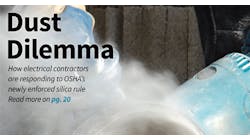As DC high-potential testing starts to show its age, test methods recommended by IEEE are ready to fill the void
For many years, high-voltage DC testing has been the traditionally accepted method to judge the serviceability of medium-voltage cables. DC high-potential (hipot) tests worked well as a withstand and condition assessment test for paper- and oil-insulated, lead-covered (PILC) cable. Even when plastic insulated cables were first introduced in the ’60s, it was still the preferred method.
Alhough applicable industry standards began to change in 1994, manufacturers, testing firms, and standards groups still agreed that DC hipot test equipment could be used to perform factory tests, acceptance tests, and maintenance tests. As far as the installer or maintenance electrician was concerned, cables that withstood the DC hipot test were good enough to be placed—or placed back—into service. But recent research and field data is calling that practice into question and raising serious doubts about whether DC hipot testing might damage or cause extruded cables—especially field aged cross-linked polyethylene (XLPE) insulated cable—to fail prematurely.
After receiving reports in the early ’90s that DC hipot testing could be to blame for latent damage experienced by extruded medium-voltage cable insulation, the Electric Power Research Institute (EPRI) funded two studies relating to XLPE and ethylene propylene rubber (EPR) cables. These studies, EPRI Reports TR-101245 and EL-6902, yielded the following conclusions regarding XLPE cable:
-
DC hipot testing of field-aged cable reduces its life.
-
DC hipot testing of field-aged cable generally increases water tree growth.
-
DC hipot testing before energizing new medium voltage cable doesn’t cause any reduction in cable life.
As noted in IEEE Standard 400-2001, Guide for Field Testing and Evaluation of Shielded Power Cable Systems, “testing of cables that have been service aged in a wet environment (specifically, XLPE) with DC at the currently recommended DC voltage levels may cause the cables to fail after they are returned to service. The failures would not have occurred at that point in time if the cables had remained in service and had not been tested with DC.” This standard also indicates other testing has shown that “even massive insulation defects in extruded dielectric insulation cannot be detected with DC at the recommended voltage levels.”
The shift in opinion of hipot testing that began in 1994 when applicable industry standards began to change is only just now gaining industry-wide acceptance. Current versions of some of these standards no longer provide for DC hipot testing of extruded cables as a maintenance test. Of those that still do, all have reduced the recommended test duration from 15 min to only 5 min. None endorses DC hipot testing as a factory test for extruded cables, but all continue to provide for DC hipot testing as an acceptance test on newly installed extruded cable. These industry standards also no longer endorse DC hipot testing as a maintenance test for extruded cables that have been in service for more than five years.
Deterioration mechanisms. Partial discharge (PD) and water intrusion are the two age-related deterioration mechanisms of most interest for both laminated (PILC) and extruded (XLPE and EPR) cable designs (see table). Although the source of PD and the process by which water enters the insulation are different for both cable types, these forms of deterioration have become a primary focus for cable manufacturers and owners.
PD can occur primarily in voids in the insulation of cables and cable accessories. Within a PILC cable, voids may result when the insulating oil migrates—due to elevation differences, cracks in the lead sheath, or incorrect assembly of terminations—away from an area within the cable. Voids in extruded cable systems can be caused by several things, including extrusion problems, improper handling during installation, or errors in termination assembly.
Whether water gets in through a crack in the lead sheath of a PILC cable or permeates through the outer layers of an extruded cable, it can result in deterioration. Moisture decreases the dielectric strength of the insulation and provides a path for leakage current or other forms of deterioration within the insulation. However, most cable experts are convinced that wet paper insulation and water trees—named for their characteristic visual pattern—in extruded insulation don’t initially produce PD. In their 1997 IEEE paper, “Mechanism for Impulse Conversion of Water Trees to Electrical Trees in XLPE,” Steven Boggs, John Densley, and Jinbo Kuang proposed that transient overvoltages were responsible for converting water trees to electrical treeing, or the degradation of electrical insulation by the formation of conductive carbonized paths, which allows for small electrical discharges. It’s commonly accepted that electrical trees do produce PD.
Condition assessment methods. IEEE Standard 400-2001 establishes six field tests for shielded power cable that can be broken down into two categories: withstand testing and condition assessment testing. DC, very low frequency, oscillating wave, and power frequency are all types of tests that fall into the first category.
Withstand tests are go/no-go tests, that involve applying an overvoltage and provide no trend data. A key concept of withstand tests is that if the overvoltage doesn’t fail the cable, the insulation condition is then considered adequate. To make a crude comparison, these tests are analogous to putting a patient on a treadmill for a predetermined time at a predetermined speed and pronouncing him healthy if he doesn’t die. Such a test overlooks the possibility of smaller problems that don’t seem like a big deal at the time. All withstand tests require the cable to be de-energized, disconnected, and tested with a special voltage source.
On the other hand, condition assessment tests involve the measurement of characteristics of the insulation. A key concept of assessment tests is that the data they compile can be trended over time to help determine whether and to what extent the insulation has deteriorated. Although some methods of performing these tests involve applying an overvoltage, it isn’t intended as a withstand test that might cause a weak spot to fail. Condition assessment tests can be further subdivided into partial discharge and dissipation factor testing.
Partial discharge tests. There are several methods for detecting and measuring PD. Some methods involve de-energizing, disconnecting, and powering the cable from a special voltage source, while other methods allow the cable to remain energized at normal line voltage. Both methods will detect and measure partial discharge in Pico Coulombs (PC). The authors of the IEEE study on water trees state that electrical trees will likely progress to failure quickly, so PD testing would be more valuable if performed in conjunction with dissipation factor/power factor (DF/PF) testing.
Dissipation factor tests. When AC voltage is applied to insulation that’s in pristine condition, the cable performs much like a capacitor: capacitive, or charging, current will flow based primarily on insulation type, cable length, and insulation geometry. Virtually no resistive current will flow, resulting in a near-zero power factor. Power factor (PF) is the ratio of resistive current to total current. Dissipation factor (DF) is the ratio of resistive current to reactive current. For small values of resistive current, PF and DF are about equal. Any form of deterioration that results in an increase of resistive current will cause a corresponding increase in PF and DF.
Since moisture in PILC cable decreases insulation resistance and allows resistive leakage current to increase, the result will be an increase in insulation PF and DF. Similarly, the presence of water trees in extruded cable will increase resistive leakage current. The manufacturers of DF testing equipment claim their products can detect moisture in PILC cable and water trees in extruded cables. All forms of available PF and DF test equipment require the cable to be de-energized, disconnected, and tested with a special voltage source.
Now that the industry has soured on DC hipot testing, cable installers and maintenance workers have had to begin looking elsewhere to judge the efficacy of medium-voltage cables. The IEEE standard for field testing and evaluating shielded power cable systems presents six options. Each test has distinct advantages and disadvantages. Of these methods, four are withstand tests. Only two provide trendable condition assessment information: PF/DF and PD. Of these, only the PD test can be performed while the cable remains energized and in service. For those applications where it’s impractical to remove cables from service to perform maintenance testing, only the online PD test offers a practical alternative.
Vahlstrom is director, technical services for Electro-Test, Inc. in San Ramon, Calif.


